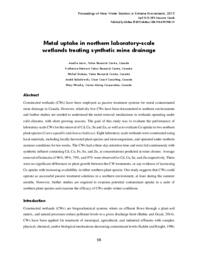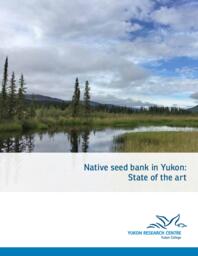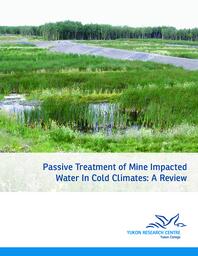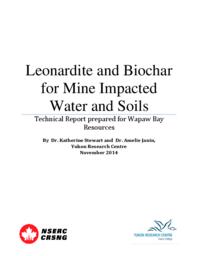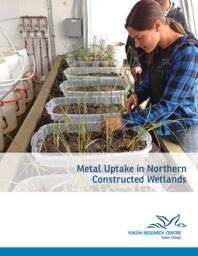Stewart, Katherine J.
Person Preferred Name
Katherine J. Stewart
Affiliation
Related Works
Content type
Digital Document
Description / Synopsis
Development of cost effective amendment technologies and restoration protocols for remediation and restoration of mine impacted sites is strongly needed in northern Canada. One of the first steps in developing successful restoration protocols is to determine and development appropriate local native plant species and soil amendments. Project Overview Kaminak Gold Corporation is currently developing a multi-million ounce, high-grade oxide gold district that is amendable to heap leaching, known as the Coffee Gold Project. The Coffee project is located in west-central Yukon Territory, approximately 130km south of Dawson City. As environmental monitoring proceeds, Kaminak Gold Corporation would like to concurrently develop restoration protocols and capacity for the Coffee Gold site. The objective of this research project was to determine target plant species and techniques for the restoration of a northern mine impacted site. Determination of target plant species included surveys of natural regeneration of existing disturbed areas and creation of a seed source map for target species. By working with Tr'ondek Hwech'in elders we included both scientific and traditional ecological knowledge in the final seed source map product, creating a resource for both industry and the local community. Site-specific restoration techniques were examined through re-vegetation and soil amendment trials on drilling fences and a nitrogen-fixing species greenhouse trial. In addition to providing important information for future mine site restoration; this project provided a unique approach to integrating research and education to simultaneously build scientific knowledge and local capacity. The research project was developed concurrently with a 12 day education course (Northern Terrestrial Restoration) offered through a collaboration between the Yukon Research Centre and the Centre for Northern Innovation in Mining at Yukon College. This course was delivered on-site with support from Kaminak Gold Corporation. The Northern Terrestrial Restoration course offered local First Nations students the opportunity to gain research experience in experimental design, field sampling techniques, as well as, native seed collection, preparation and storage providing a foundation for future local community involvement in restoration and horticulture of native plants. Through directly integrating research and education we aim to take the first steps in not only identifying, preserving and testing materials for restoration of the Coffee Gold Project, but also in determining effective restoration protocols and building capacity for native plant horticulture in Yukon communities.
Origin Information
Content type
Digital Document
Description / Synopsis
Constructed wetlands (CWs) have been employed as passive treatment systems for metal contaminated mine drainage in Canada. However, relatively few CWs have been documented in northern environments and further studies are needed to understand the metal removal mechanisms in wetlands operating under cold climates, with short growing seasons. The goal of this study was to evaluate the performance of laboratory-scale CWs for the removal of Cd, Cu, Se and Zn, as well as to evaluate Cu uptake in two northern plant species (Carex aquatilis and Juncus balticus). Eight laboratory-scale wetlands were constructed using local materials, including locally harvested plant species and microorganisms, and operated under northern summer conditions for ten weeks. The CWs had a three-day retention time and were fed continuously with synthetic influent containing Cd, Cu, Fe, Se, and Zn, at concentrations predicted at mine closure. Average removal efficiencies of 96%, 99%, 79%, and 97% were observed for Cd, Cu, Se, and Zn respectively. There were no significant differences in plant growth between the CW treatments, or any evidence of increasing Cu uptake with increasing availability in either northern plant species. Our study suggests that CWs could operate as successful passive treatment solutions in a northern environment, at least during the summer months. However, further studies are required to examine potential contaminant uptake in a suite of northern plant species and examine the efficacy of CWs under winter conditions.
Origin Information
Content type
Digital Document
Description / Synopsis
The revegetation needs in the Yukon are projected to grow in the next few years as new mining projects go through the environmental assessment process, and plans for the revegetation of large-scale abandoned mines begin to take shape. Revegetation strategies and needs vary within the Yukon, but when dispersing seed or using seedlings, the use of native species that are locally produced is considered best practice. The lack of a clear source for this type of material was indicated as a barrier to the implementation of these best practices in the Yukon. To explore this topic further, industry, consultants, and experts involved in seed collection, storing, sourcing, and propagation initiatives were interviewed. This report is based on those interviews and examines the state of revegetation in the Yukon, current options for native seed sourcing, and potential future options that would increase access to native seeds in the territory. These options include the development of seed collection, banking, and propagation initiatives, as well as educational programming to support these initiatives. Several case studies are included, both covering local initiatives and initiatives in other jurisdictions that are relevant to the Yukon and could be used as a model for local seed and plant sourcing initiatives.
Origin Information
Content type
Digital Document
Description / Synopsis
In this review, we evaluate the challenges encountered and the adaptations required for the successful treatment of mine-impacted waters in cold climates with Passive Treatment Systems (PTSs). Engineered PTSs are modeled on natural wetlands, which have been shown to effectively treat water with high metal concentrations through natural attenuation. PTSs include constructed wetlands, bioreactors, and hybrid systems. Some of the challenges associated with implementing cold climate PTSs include cold temperatures, remote locations and limited access in winter, which can lead to freezing pipes and surface water, variable seasonal flow, and low productivity of microbial and macrophytic communities. Many adaptations have been implemented to address these cold climate challenges including burial of pipes to avoid hydraulic failure, insulation to avoid freezing surface waters, bypasses and overflows to maintain constant flow, summer establishment of microbial and macrophytic communities and the addition of liquid carbon sources to offset reduced organic matter decomposition in cold temperatures. While further investigation and development is necessary to fully understand the factors affecting cold climate PTSs, with sufficient research and planning PTSs can be successfully implemented in cold climates.
Origin Information
Content type
Digital Document
Description / Synopsis
In situ immobilization of metals using soil amendment processes is increasingly being considered as an effective and low cost remediation alternative (Mench et al. 2007, Kumpiene et al. 2008, Fellet et al. 2011). Leonardite is a carbon-rich material derived from the oxidation of Lignite and is rich in humic acid, whereas biochar is a product that results from the oxygen limited, pyrolysis of various biological ingredients, such as wood, fish or animal bone. Several studies have found biochar amendments result in significant decreases in the bioavailability of heavy metals associated with mining impacted soils (Namgay et al. 2006, Fellet et al. 2011, Beesley et al. 2010) and simultaneously improve physical, chemical and biological soil properties (Laird et al. 2010). Leonardite is known to improve soil conditions (Lao et al. 2005, Zeledόn- Torunõ et al. 2005, Madejόn et al. 2010) and has potential to significantly reduce metal bioavailability due to high metal adsorption capacity (Lao et al. 2005, Zeledόn- Torunõ et al. 2005).
Origin Information
Content type
Digital Document
Description / Synopsis
Constructed wetlands (CWs) have been employed as passive treatment systems for metal contaminated mine drainage in Canada. However, relatively few CWs have been documented in northern environments and further studies are needed to understand the metal removal mechanisms in wetlands operating under cold climates, with short growing seasons. The goal of this study was to evaluate the performance of laboratory-scale CWs for the removal of Cd, Cu, Se and Zn, as well as, to evaluate Cu and Se uptake in two northern plant species (Carex aquatilis and Juncus balticus). Eight laboratory-scale wetlands were constructed using local materials, including locally harvested plant species and microorganisms and operated under northern summer conditions for 10 weeks. The CWs were fed continuously with synthetic influent containing Cd, Cu, Fe, Se and Zn at concentrations predicted at mine closure. Average removal efficiencies of 96%, 99%, 79% and 97% were observed for Cd, Cu, Se and Zn respectively. There were no significant differences in plant establishment or growth between our CW treatments, or any evidence of increasing Cu uptake with increasing contaminant availability in either northern plant species. Increased belowground uptake of Se was observed at the higher influent concentration in the Pit treatment. However, overall our study suggests that uptake of contaminants by these two northern species is very minor (<0.06% Cu and <0.11% Se, except for C. aquatilis in one treatment <0.2% Cu and <0.4 % Se) and likely does not pose a risk to the surrounding environment. We conclude that CWs could operate as successful passive treatment solutions in a northern environment, at least during the summer months, pending further studies on winter treatment. Further studies are required to examine seasonal metal removal rates in relation to rates of sulfate reduction, carbon consumption, metal precipitation and sorption. In addition, potential contaminant uptake and the influence of functional plant characteristics on metal removal in a suite of northern plant species would further assist in the development of large-scale long-term northern CWs.
Origin Information


